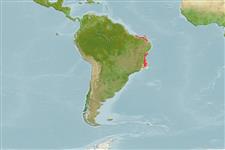Common names from other countries
Classification / Names / Names
ماع يماسا | فدارتم | Catalog of Fishes (gen., sp.) | ITIS | CoL | WoRMS
Environment: milieu / climate zone / depth range / distribution range
يسانش موب
; قمع تارييغت 0 - 30 m (Ref. 848). Tropical; 1°S - 25°S, 45°W - 37°W (Ref. 848)
Southwest Atlantic: Tamandare and Abrolhos Islands, Brazil.
Length at first maturity / Size / Weight / نس
Maturity: Lm ? range ? - ? cm
Formation: with tubular corallites, often over 1 m across. Individual or small group of corallites usually not connected, i.e., have dead basal connections, and are easily broken and scattered. Corallites: rounded, in varied shapes averaging 15 to 20 mm diameter. Septa: rounded, bead-like dentations only in living colonies. Color: mostly bluish-gray (Ref. 848).
Occurs in shallow turbid reef environments (Ref. 848).
Life cycle and mating behavior
غولب | لثم دیلوت | یزیر مخت | اه مخت | Fecundity | )ورال ( دازوت
Members of the class Anthozoa are either gonochoric or hermaphroditic. Mature gametes are shed into the coelenteron and spawned through the mouth. Life cycle: The zygote develops into a planktonic planula larva. Metamorphosis begins with early morphogenesis of tentacles, septa and pharynx before larval settlement on the aboral end.
یلصا ذخآم
عجارم | هدننك گنهامه | ناراكمه
Veron, J.E.N. 2000. (Ref. 848)
NCUI زمرق تسرهف رد تيعضو (Ref. 130435)
ستياس رظن زا تيعضو (Ref. 108899)
Not Evaluated
یناسنا هدافتسا
| FishSource |
اهرازبا
رتشيب تاعالطا
Age/Sizeدشرنزو - لوطلوط - لوطيسانش تخير)ورال ( دازوتيناوارف
يتنرتنيا عبانم
Estimates based on models
Preferred temperature
(Ref.
115969): 25.9 - 27.6, mean 27 (based on 87 cells).
تميق هقبط
Unknown.
